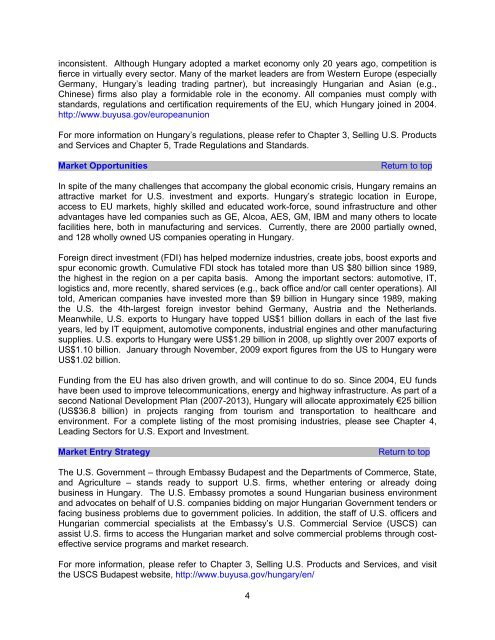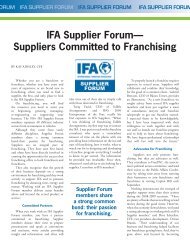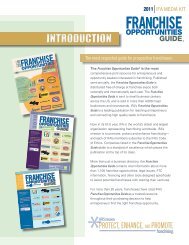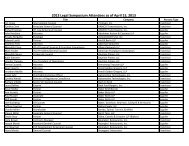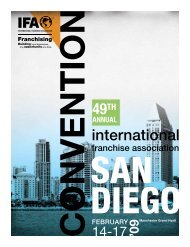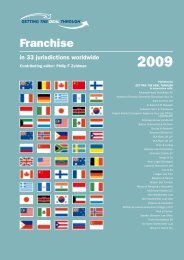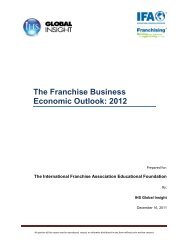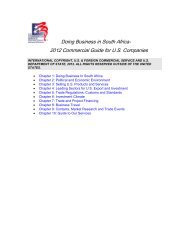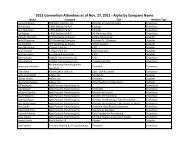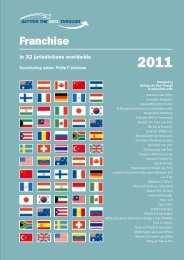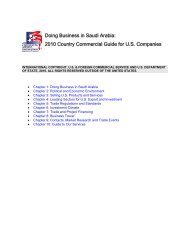Doing Business in Hungary 2010 - International Franchise Association
Doing Business in Hungary 2010 - International Franchise Association
Doing Business in Hungary 2010 - International Franchise Association
Create successful ePaper yourself
Turn your PDF publications into a flip-book with our unique Google optimized e-Paper software.
<strong>in</strong>consistent. Although <strong>Hungary</strong> adopted a market economy only 20 years ago, competition is<br />
fierce <strong>in</strong> virtually every sector. Many of the market leaders are from Western Europe (especially<br />
Germany, <strong>Hungary</strong>’s lead<strong>in</strong>g trad<strong>in</strong>g partner), but <strong>in</strong>creas<strong>in</strong>gly Hungarian and Asian (e.g.,<br />
Ch<strong>in</strong>ese) firms also play a formidable role <strong>in</strong> the economy. All companies must comply with<br />
standards, regulations and certification requirements of the EU, which <strong>Hungary</strong> jo<strong>in</strong>ed <strong>in</strong> 2004.<br />
http://www.buyusa.gov/europeanunion<br />
For more <strong>in</strong>formation on <strong>Hungary</strong>’s regulations, please refer to Chapter 3, Sell<strong>in</strong>g U.S. Products<br />
and Services and Chapter 5, Trade Regulations and Standards.<br />
Market Opportunities Return to top<br />
In spite of the many challenges that accompany the global economic crisis, <strong>Hungary</strong> rema<strong>in</strong>s an<br />
attractive market for U.S. <strong>in</strong>vestment and exports. <strong>Hungary</strong>’s strategic location <strong>in</strong> Europe,<br />
access to EU markets, highly skilled and educated work-force, sound <strong>in</strong>frastructure and other<br />
advantages have led companies such as GE, Alcoa, AES, GM, IBM and many others to locate<br />
facilities here, both <strong>in</strong> manufactur<strong>in</strong>g and services. Currently, there are 2000 partially owned,<br />
and 128 wholly owned US companies operat<strong>in</strong>g <strong>in</strong> <strong>Hungary</strong>.<br />
Foreign direct <strong>in</strong>vestment (FDI) has helped modernize <strong>in</strong>dustries, create jobs, boost exports and<br />
spur economic growth. Cumulative FDI stock has totaled more than US $80 billion s<strong>in</strong>ce 1989,<br />
the highest <strong>in</strong> the region on a per capita basis. Among the important sectors: automotive, IT,<br />
logistics and, more recently, shared services (e.g., back office and/or call center operations). All<br />
told, American companies have <strong>in</strong>vested more than $9 billion <strong>in</strong> <strong>Hungary</strong> s<strong>in</strong>ce 1989, mak<strong>in</strong>g<br />
the U.S. the 4th-largest foreign <strong>in</strong>vestor beh<strong>in</strong>d Germany, Austria and the Netherlands.<br />
Meanwhile, U.S. exports to <strong>Hungary</strong> have topped US$1 billion dollars <strong>in</strong> each of the last five<br />
years, led by IT equipment, automotive components, <strong>in</strong>dustrial eng<strong>in</strong>es and other manufactur<strong>in</strong>g<br />
supplies. U.S. exports to <strong>Hungary</strong> were US$1.29 billion <strong>in</strong> 2008, up slightly over 2007 exports of<br />
US$1.10 billion. January through November, 2009 export figures from the US to <strong>Hungary</strong> were<br />
US$1.02 billion.<br />
Fund<strong>in</strong>g from the EU has also driven growth, and will cont<strong>in</strong>ue to do so. S<strong>in</strong>ce 2004, EU funds<br />
have been used to improve telecommunications, energy and highway <strong>in</strong>frastructure. As part of a<br />
second National Development Plan (2007-2013), <strong>Hungary</strong> will allocate approximately €25 billion<br />
(US$36.8 billion) <strong>in</strong> projects rang<strong>in</strong>g from tourism and transportation to healthcare and<br />
environment. For a complete list<strong>in</strong>g of the most promis<strong>in</strong>g <strong>in</strong>dustries, please see Chapter 4,<br />
Lead<strong>in</strong>g Sectors for U.S. Export and Investment.<br />
Market Entry Strategy Return to top<br />
The U.S. Government – through Embassy Budapest and the Departments of Commerce, State,<br />
and Agriculture – stands ready to support U.S. firms, whether enter<strong>in</strong>g or already do<strong>in</strong>g<br />
bus<strong>in</strong>ess <strong>in</strong> <strong>Hungary</strong>. The U.S. Embassy promotes a sound Hungarian bus<strong>in</strong>ess environment<br />
and advocates on behalf of U.S. companies bidd<strong>in</strong>g on major Hungarian Government tenders or<br />
fac<strong>in</strong>g bus<strong>in</strong>ess problems due to government policies. In addition, the staff of U.S. officers and<br />
Hungarian commercial specialists at the Embassy’s U.S. Commercial Service (USCS) can<br />
assist U.S. firms to access the Hungarian market and solve commercial problems through costeffective<br />
service programs and market research.<br />
For more <strong>in</strong>formation, please refer to Chapter 3, Sell<strong>in</strong>g U.S. Products and Services, and visit<br />
the USCS Budapest website, http://www.buyusa.gov/hungary/en/<br />
4


